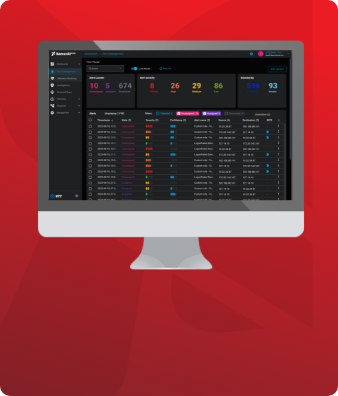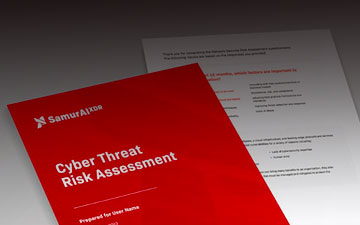The cybersecurity field is one of tech’s most rapidly evolving areas. New threats are being uncovered all the time, and new defenses are being discovered and implemented, too.
And at the core of this rapid evolution is AI. Cybersecurity and AI can work together to create a bright and powerful future for businesses and institutions. This post will look at how artificial intelligence has evolved over the years and how it can be implemented in real-world use cases.
The evolution of AI in cybersecurity
Let's start by looking at the evolution of artificial intelligence in cybersecurity. While we often hear the term "AI" used in a catch-all way, it's much more nuanced than you might think. So to help you understand the evolution of AI in cybersecurity, here's a quick breakdown.
Assisted intelligence
The first type of artificial intelligence in cybersecurity is assisted intelligence. This is a type of AI that helps us with tasks that we're already doing. If you have a virtual assistant on your smartphone, then the majority of the tasks that it's performing are assisted intelligence.
In other words, assisted intelligence performs tasks that we could do ourselves, but it's faster or more convenient to have an AI handle it for us.
While handy, this type of artificial intelligence isn't very powerful or particularly useful in cybersecurity. It's largely a time-saver, though it is an essential step in the growth of AI and cybersecurity.
Augmented intelligence
The next step up from assisted intelligence is augmented intelligence. This is any kind of AI that helps people or organizations accomplish tasks they otherwise couldn't.
For example, this type of AI can help you solve complex equations, catch cybersecurity threats across your organization, or automate a tedious and complicated task.
You still need to interact with the AI to tell it what to do and when. But the tasks it's accomplishing are ones that the average person either can't accomplish or couldn't without a significant amount of time and resources.
Autonomous intelligence
And that brings us to the last step in AI's evolution — autonomous intelligence. As the name suggests, autonomous intelligence is any AI that functions on its own without the need for human intervention.
This type of AI is still a ways off, but we're getting closer to it every day. A familiar example of this is the completely self-driving vehicle. You hop in the passenger seat and read a book or take a nap while your car takes you to your destination.
It's the most valuable type of AI and also the hardest to produce. But we're gradually getting closer to making this AI a reality, so it's only a matter of time before it has a serious and beneficial impact on the cybersecurity sector.
6 applications of AI in cybersecurity
Now that you know how AI and cybersecurity have evolved let's look at specific use cases for AI in cybersecurity today. These are real-world examples that you can benefit from right now with the right investments.
Zero-day malware
Zero-day malware is a growing risk in cybersecurity. This malware is created and deployed to exploit a vulnerability that the software vendor doesn’t know about yet. In this kind of situation you can’t protect yourself by installing a software update, because a patch to protect against the attack does not exist yet.
Fortunately, AI can be a massive help here. It can spot suspicious behaviors instantly, preventing malware from taking root. For example, a piece of malware may attempt something seemingly innocuous, like moving files or trying to hide. An AI can recognize these behaviors and flag them instantly.
Identifying and prioritizing threats
Given the rising number of threats organizations face today, it can be challenging to prioritize threats that coincide.
An AI can not only spot threats exceptionally quickly, but it can also rank them against one another as well. This ranking considers factors like intent, risk level, and time to defuse a situation. This helps you to prioritize which threats to attend to first.
Automated actions
While autonomous AI can act without the need for human interference even augmented intelligence can be a big help in automating both complex and repetitive tasks. This allows it to take automated measures to protect your organization against a cybersecurity threat.
This is immensely valuable, because modern threats can work through your network of devices in a matter of minutes. An automatic and intelligent way to address incoming threats is necessary in today's world.
Managing the avalanche of data
The sheer number of devices that organizations are having to secure these days is creating an avalanche of data. This includes desktops, tablets, wearables, smartphones, and other smart devices. As events flood in from all of these devices it becomes impossible to detect threats manually, or even using fixed rulesets. AI techniques like machine learning (ML) make it possible to correlate events from multiple devices and detect the movements of even stealthy adversaries. Extended Detection and Response (XDR) is a good example of a toolset which leverages AI and in particular ML to find the proverbial “needle in a haystack” to detect threats by interpreting the deluge of data presented by all of the devices in an organization. Where your cybersecurity team will be overwhelmed, your AI will thrive.
Addressing multiple incoming threats simultaneously
Another way that AI and cybersecurity complement one another is in their ability to assess multiple incoming threats simultaneously. While that may sound unlikely, it's actually a strategy used by certain threat actors.
Again, this can quickly overwhelm even the best cybersecurity teams. But with an AI, handling this sort of situation is simple. The AI can tackle all incoming threats at once without missing a beat.
Supplementing the cybersecurity talent gap
Finally, AI can be used in cybersecurity to close your business's talent gap. Not all cybersecurity experts are created equal, and even the best experts are limited by human error, fatigue, and the simple fact that they can't work around the clock.
As you might have guessed, none of these factors negatively impacts an AI. For this reason alone, it's clear that AI is the future of cybersecurity.
AI is already revolutionizing the cybersecurity industry
These are just a handful of ways that AI and cybersecurity are working together to change the cybersecurity sector for the better. This revolutionary technology aligns with the goals of cybersecurity, making for a surprisingly effective pairing. We're excited to see how the advancement of AI will continue to advance the efforts of cybersecurity.
The use of AI in tools like XDR is making it possible to manage the massive amounts of telemetry data emanating from modern IT environments and correlate events from diverse sources to uncloak even the most stealthy adversaries.
For more information about how you can harness the power of AI to protect your business, get in touch with our Samurai XDR experts today!
Featured articles
Identity Management in the Physical and Digital Worlds
7 August 2024 | Webinars
In today's rapidly evolving world, managing identities securely and efficiently is more crucial than ever. Join us for an insightful...
Identity Management in the Physical and Digital Worlds
30 July 2024 | Webinars
In today's rapidly evolving world, managing identities securely and efficiently is more crucial than ever. Join us for an insightful...
XDR for Small and Medium Businesses: Is It Worth It?
24 July 2024 | XDR
Cybersecurity is of paramount importance to virtually all organizations and SMBs have to address several specific challenges. The failure to...





